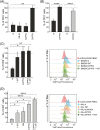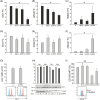The immunosuppression pathway of tumor-associated macrophages is controlled by heme oxygenase-1 in glioblastoma patients
- PMID: 36054818
- PMCID: PMC9825884
- DOI: 10.1002/ijc.34270
The immunosuppression pathway of tumor-associated macrophages is controlled by heme oxygenase-1 in glioblastoma patients
Abstract
The immunosuppressive tumor microenvironment (TME) in glioblastoma (GBM) is mainly driven by tumor-associated macrophages (TAMs). We explored whether their sustained iron metabolism and immunosuppressive activity were correlated, and whether blocking the central enzyme of the heme catabolism pathway, heme oxygenase-1 (HO-1), could reverse their tolerogenic activity. To this end, we investigated iron metabolism in bone marrow-derived macrophages (BMDMs) isolated from GBM specimens and in in vitro-derived macrophages (Mφ) from healthy donor (HD) blood monocytes. We found that HO-1 inhibition abrogated the immunosuppressive activity of both BMDMs and Mφ, and that immunosuppression requires both cell-to-cell contact and soluble factors, as HO-1 inhibition abolished IL-10 release, and significantly reduced STAT3 activation as well as PD-L1 expression. Interestingly, not only did HO-1 inhibition downregulate IDO1 and ARG-2 gene expression, but also reduced IDO1 enzymatic activity. Moreover, T cell activation status affected PD-L1 expression and IDO1 activity, which were upregulated in the presence of activated, but not resting, T cells. Our results highlight the crucial role of HO-1 in the immunosuppressive activity of macrophages in the GBM TME and demonstrate the feasibility of reprogramming them as an alternative therapeutic strategy for restoring immune surveillance.
Keywords: glioblastoma; heme oxygenase-1; iron metabolism; macrophages; tumor microenvironment.
© 2022 The Authors. International Journal of Cancer published by John Wiley & Sons Ltd on behalf of UICC.
Conflict of interest statement
The authors report that there are no competing interests to declare.
Figures






Similar articles
-
Tumor cell-released autophagosomes (TRAPs) promote immunosuppression through induction of M2-like macrophages with increased expression of PD-L1.J Immunother Cancer. 2018 Dec 18;6(1):151. doi: 10.1186/s40425-018-0452-5. J Immunother Cancer. 2018. PMID: 30563569 Free PMC article.
-
Phagocytosis of Glioma Cells Enhances the Immunosuppressive Phenotype of Bone Marrow-Derived Macrophages.Cancer Res. 2023 Mar 2;83(5):771-785. doi: 10.1158/0008-5472.CAN-22-1570. Cancer Res. 2023. PMID: 36622331 Free PMC article.
-
The Diverse Roles of Heme Oxygenase-1 in Tumor Progression.Front Immunol. 2021 Mar 31;12:658315. doi: 10.3389/fimmu.2021.658315. eCollection 2021. Front Immunol. 2021. PMID: 33868304 Free PMC article. Review.
-
Taraxacum mongolicum extract inhibited malignant phenotype of triple-negative breast cancer cells in tumor-associated macrophages microenvironment through suppressing IL-10 / STAT3 / PD-L1 signaling pathways.J Ethnopharmacol. 2021 Jun 28;274:113978. doi: 10.1016/j.jep.2021.113978. Epub 2021 Mar 11. J Ethnopharmacol. 2021. PMID: 33716082
-
Tumor-Associated Macrophages Regulate PD-1/PD-L1 Immunosuppression.Front Immunol. 2022 May 3;13:874589. doi: 10.3389/fimmu.2022.874589. eCollection 2022. Front Immunol. 2022. PMID: 35592338 Free PMC article. Review.
Cited by
-
The promise of targeting heme and mitochondrial respiration in normalizing tumor microenvironment and potentiating immunotherapy.Front Oncol. 2023 Jan 4;12:1072739. doi: 10.3389/fonc.2022.1072739. eCollection 2022. Front Oncol. 2023. PMID: 36686754 Free PMC article. Review.
-
Cytoprotective Role of Heme Oxygenase-1 in Cancer Chemoresistance: Focus on Antioxidant, Antiapoptotic, and Pro-Autophagy Properties.Antioxidants (Basel). 2023 Jun 5;12(6):1217. doi: 10.3390/antiox12061217. Antioxidants (Basel). 2023. PMID: 37371947 Free PMC article. Review.
-
Present and Future of Immunotherapy in Patients With Glioblastoma: Limitations and Opportunities.Oncologist. 2024 Apr 4;29(4):289-302. doi: 10.1093/oncolo/oyad321. Oncologist. 2024. PMID: 38048782 Free PMC article. Review.
-
The immune cell landscape of glioblastoma patients highlights a myeloid-enriched and immune suppressed microenvironment compared to metastatic brain tumors.Front Immunol. 2023 Oct 23;14:1236824. doi: 10.3389/fimmu.2023.1236824. eCollection 2023. Front Immunol. 2023. PMID: 37936683 Free PMC article.
-
Comparable safety profile between neuro-oncology procedures involving stereotactic needle biopsy (SNB) followed by laser interstitial thermal therapy (LITT) and LITT alone procedures.J Neurooncol. 2023 Mar;162(1):147-156. doi: 10.1007/s11060-023-04275-w. Epub 2023 Mar 15. J Neurooncol. 2023. PMID: 36920678
References
-
- Bejarano L, Jordao MJC, Joyce JA. Therapeutic targeting of the tumor microenvironment. Cancer Discov. 2021;11(4):933‐959. doi:10.1158/2159-8290.CD-20-1808 - DOI - PubMed
Publication types
MeSH terms
Substances
LinkOut - more resources
Full Text Sources
Research Materials
Miscellaneous

